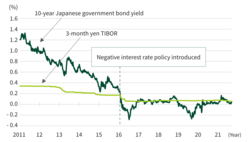8. Operating in a negative-interest-rate environment
Japan’s economy moved into a phase of mild recovery beginning in late 2012. Nonetheless, the domestic economy was not strong enough to achieve the BOJ’s target of 2% annual growth in consumer prices. Outside Japan, a number of unfavorable factors—such as the slowdown of China and other emerging-market countries and a stagnant natural resources market—suggested an uncertain outlook for the world economy. Against this backdrop, the BOJ decided to introduce the policy of quantitative and qualitative monetary easing with a negative interest rate (negative interest rate policy) in January 2016, which went into effect on February 16.
This policy measure effectively pushed down the yield curve. However, the introduction of the negative interest rate policy and lower bond yields would generally reduce income in the banking sector. For SMBC’s Treasury Unit, it meant that returns on Japanese government bond portfolios would diminish in the future.
To address this situation, the Treasury Unit rebalanced the portfolios in a flexible manner to increase income while carefully watching changes in monetary policies overseas, market trends affected by political situations and economic conditions. Also, anticipating the prolonged implementation of the negative interest rate policy and lower interest rates globally, the unit expanded the eligible category of investment to include corporate bonds and emerging-market sovereign bonds on top of the existing portfolio, comprised of stocks and bonds.

-
Chapter 1The Financial Crisis and Realignment of the Financial Sector
-
Chapter 2The Birth of SMBC and SMFG
-
Chapter 3Initiatives Pursued by SMBC Banking Units in the Early Years
-
Chapter 3Initiatives Pursued by SMBC Banking Units in the Early Years
-
- Enhancing our retail consulting and payments & consumer finance businesses
- Enhancing corporate financial solutions
- Banking-Securities collaboration in the wholesale securities business
- Challenges facing our global banking business
- Actions by Treasury Unit in preparation for rising interest rates
- Integration of operating systems and administrative functions
-
-
-
Chapter 4Embarking on Fresh Challenges Under New Leadership
-
Chapter 4Embarking on Fresh Challenges Under New Leadership
-
- Changes of leadership and the announcement of our new management policy
- Developing group business strategies
- Addressing antitrust issues
- Completing repayment of public funds
- LEAD THE VALUE
- Enhancing our retail financial consulting business
- Enhancing our corporate solution business
- Enhancing our investment banking business
- Global banking business turnaround
- Upgrading risk management in preparation for Basel II
- Development of human resources
- CSR activities
-
-
-
Chapter 5SMFG’s Response to Global Economic and Financial Turmoil
-
Chapter 6Preparing for the Next Decade
-
Chapter 1Business Model Reform Under Challenging Business Conditions
-
Chapter 1Business Model Reform Under Challenging Business Conditions
-
- Our journey under new leadership (the second decade)
- Focusing on growth industries and businesses
- Reforming domestic business operations
- Promoting banking-securities collaboration in Wholesale Banking Unit
- Structural reform of our retail business
- Meeting the needs of an aging society
- Abenomics and Treasury Unit's nimble portfolio management
- Operating in a negative-interest-rate environment
-
-
-
Chapter 2Enhancing Group Businesses
-
Chapter 3Expanding Our Global Business
-
Chapter 4Enhancing Corporate Infrastructure Under a New Governance Framework
-
Chapter 4Enhancing Corporate Infrastructure Under a New Governance Framework
-
- New leadership and enhancing corporate governance
- Introducing group-wide business units and CxO system
- Improving capital, asset, and cost efficiency
- Pursuing our cashless payment strategies
- Retail branch reorganization
- Customer-oriented business conduct
- Enhancing internal-control frameworks
- Valuing diversity and revision of our HR framework
-
-
-
Chapter 5The Path for Our Future
-
Chapter 6Opening a New Chapter in SMBC Group’s History
